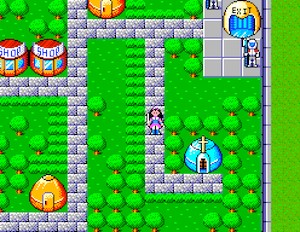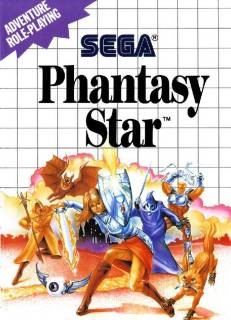It's fair to say Sega's humble 8-bit system didn't have many stand-out classics that have echoed down the decades in the same way as the Nintendo Entertainment System had, but here's one of them. Hitting the shelves way back in 1988, Phantasy Star was Sega's me too answer to a plethora of role-playing games released for Nintendo's machine. Save the Zelda franchise (which, in my opinion, is an action/arcade adventure rather than RPG), Phantasy Star was a real step over the likes of Dragon Quest and Final Fantasy, and laid the groundwork for the sub-genre now known as Japanese RPGs.
I never encountered this game upon its release. Then I was high in Spectrum heaven, while my Master System-owning mate was only really interested in arcade stuff like Rampage and Thunderblade. But years later I picked up the third game in the series, the (now maligned) Phantasy Star III, which I played to death over the course of a summer. More of that on another occasion, but PSIII introduced me well to the universe in which the series is set, as well as the combat system and game structure. Hence when I finally got round to Phantasy Star proper it was like revisiting an old, kindly friend.

Phantasy Star on the surface doesn't look too special. You guide your player character around on overworld, dropping into towns for shopping and quest hints, and nipping into dungeons to find treasures and advance the plot. There's more to it. First off, and very rare for the time, the star lead of Sega's RPG flagship was Alis, a woman. Yikes! She is pulled into a vengeance quest against Lassic, a formerly benevolent ruler-turned-dark who reigns over the three planets of the Algol star system. Lassic had previously crushed an uprising led by Nero, Alis's brother, and the game begins with his expiration and her oath to crush her brother's nemesis. Over the course of the game, Alis meets and adds further characters to her party - Myau, a proto-Pikachu, Odin - a well-meaning axe-wielding meat head, and Noah, the game's resident magic user. The second innovation: JRPGs regularly blend magic and high technology, but this was the first game to do it. You shuffle about the game world taking on monsters with swords, claws, axes, and staffs. And you can also acquire light sabres, laser guns and enchanted weaponry. Third, as this is a multi-planet system there are actually three game worlds. To start off with you buy passage on a ship to visit the desert world, and later you acquire a ship of your own to allow access to a third, ice planet. All have to be visited multiple times to explore the towns and the dungeons. And that's the fourth - breath-taking - innovation. All the dungeons are rendered in three dimensions. It's simple but looks absolutely stunning - even better than the overhead dungeon sections that afflicted its 16-bit sequels.
In short, there was nothing on the NES that could hold a candle to it. It's just a shame it didn't help shift Master Systems in massive numbers, nor at the time was it particularly well-regarded in Europe. A pity, because it plays well and there are hours of exploring to be had. A true classic, in other words.

Yet, for all its innovations, it rested on staples which, by 1988, were already very well-established conventions. Like table top RPGs of old, characters had levelling systems. Combat was by the random throw of virtual dice, albeit heavily modified by increasing one's combat-related attributes, and to become more powerful you had to grind. i.e. Wander around world maps/dungeons to fight monsters, carry off their cash and items for powerful weaponry and/or vehicles, and accumulate experience points so one becomes tougher and stronger. It's long been noted in the critical study of video games that these sorts of mechanics are congruent with the neoliberal sensibility of the times. Beating a game is about accumulating material and experiential resources, as in-game capital of one type that can be traded in for in-game capital of another. Trips out into the wilderness become less about questing and more about repeating simple abstract processes. Except this time it's not about the seeking of ephemeral experiences to pad the game out - grinding is accumulation for accumulation's sake. You can never be too hard or too tough for the nasties Phantasy Star - and other JRPGs - throw at you.
While you might argue it's difficult to understand how the mechanics of an RPG can work without a numbers system underpinning it, the game works to normalise the planning and execution of accumulation strategies semi-independently of the tightly-structured story (being an early JRPG, there are no side-quests to speak of). It simulates and inculcates habits that underpin actually existing economic relationships. Neoliberal sensibilities also work on the surface of the game as well. As you walk your way through the three worlds, you get a sense of how sparse they are. Considering you're part of a space-faring civilisation, towns are few and far between and they're sparsely populated. You visit and very little, if anything, changes between trips. An area might have been unlocked because of actions taken elsewhere, but the same people stand around in the same places and have exactly the same snippets of information to say. True, there was only so much cartridge space Sega had to play with, yet the effect is a world where you're the only active element. Nothing is time limited. The quest is still there if you decide to spend 20 hours knocking around the backwoods of the ice planet hunting for White and Blue Dragons - and by extension, experience points.

This is a theme that comes up time and again in our culture, in games and on television. The world is something that exists for you to assert yourself against it, whether as an individual battling against faceless, anonymous hordes or, in this case, a static world that changes in part only because of your actions. There is congruence here between Phantasy Star's world and the active consuming individual patronised and valorised by contemporary consumer cultures. You are flattered and seduced for the contents of your purse and wallet, feted as if the world revolves around you, that it exists for the sating of your desires - whatever they may be. Phantasy Star reflects the culture that spawned it, but also unconsciously embeds those logics into the structure of the game.
When you assume the mantle of Alis and accept her quest to avenge her brother, you're playing her role. And on top of that, you're roleplaying a banal, oft-unremarked, but absolutely crucial constituent of neoliberal consumer culture.




No comments:
Post a Comment